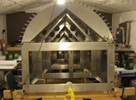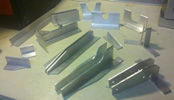


random user submitted photo
Generator switch off
28 posts
• Page 3 of 3 • 1, 2, 3
Re: Generator switch off
Guys,
Thanks- this is what I might expect, but not what I hoped for.
Anyway- I will need a new TPX: E-bay, here I come! I understand that the solid state King KT76C is a direct slide-in replacement for the 'A' model: is there anybody who can confirm this?
I got my hopes up when I read about the diode across the starter relay: am I to understand that even this does not warrant trouble free operation?
Thanks
Kai
Sonex0525
Thanks- this is what I might expect, but not what I hoped for.
Anyway- I will need a new TPX: E-bay, here I come! I understand that the solid state King KT76C is a direct slide-in replacement for the 'A' model: is there anybody who can confirm this?
I got my hopes up when I read about the diode across the starter relay: am I to understand that even this does not warrant trouble free operation?
Thanks
Kai
Sonex0525
Sonex A #0525- SG, DS.
EdgePerfomance EP915ECI, 123HP
EdgePerfomance EP915ECI, 123HP
- Kai
- Posts: 305
- Joined: Wed Jul 30, 2014 1:36 am
- Location: ICAO ENHS
Re: Generator switch off
radfordc wrote:Do we understand the "E = I x R" formula?
While this is indisputable, using just a fuse is problematic as you must find the right balance between eliminating nuisance trips and failing to work when you need it.
The simple over voltage circuits work quickly, simply and reliably at a precise voltage point. They trigger a dead short through a small inline fuse that opens a small 12v 40A relay when it blows, disconnecting the circuit between the voltage regulator and the bus.
Last edited by n982sx on Mon Mar 26, 2018 3:21 pm, edited 1 time in total.
Bob Meyers
Built and Flying Sonex N982SX http://n982sx.com
Built and Flying RV-14 N626KM http://n626km.com
Built and Flying Sonex N982SX http://n982sx.com
Built and Flying RV-14 N626KM http://n626km.com
-

n982sx - Posts: 113
- Joined: Tue Sep 03, 2013 11:45 pm
- Location: Chicago, IL
Re: Generator switch off
Kai wrote:I got my hopes up when I read about the diode across the starter relay: am I to understand that even this does not warrant trouble free operation?
Unforutnately there's not a simple answer. Diodes will help, but how susceptible your equipment is to being harmed under different scenarios really depends on how each piece of gear was designed and tested. I highly recommend reading these Bob Nuckolls articles to understand over-voltage spikes and under-voltage issues:
http://www.aeroelectric.com/articles/avmaster.pdf
http://www.aeroelectric.com/articles/DO-160.pdf
Take care,
--Noel
- NWade
- Posts: 527
- Joined: Mon Aug 08, 2011 3:58 pm
Re: Generator switch off
N190YX wrote:You never, ever want to have any avionics on when starting the engine.
Yikes, I guess starting my aircraft nearly a thousand times in the last 10 years with the avionics and strobes on must have cost me thousands of dollars in repairs.
The voltage spikes and issues revolving around starting our aircraft engines have been well understood for a long time. The simple snubber diode on our contactors/relays have long been used to protect them. The resulting spikes and voltage drops are not mysterious things. I know of no current avionics products that aren't compliant with DO-160 which describe in detail what our current avionics are supposed to be able to handle without damage, and that includes starter voltage spikes.
I can't state that older products like the KX-155 or non solid state devices might not be damaged, but all our current devices shouldn't even blink at the voltage spikes.
The biggest problem with most devices now is simply not getting enough juice during start, causing them to reboot. It is silly to put in a modern EFIS with built in engine monitoring and not have it available during startup. I also consider a strobe light to be an important safety item to be on during engine startup.
The reboot issue can be solved several ways. In my Sonex with an Enigma, I had a very small 2ah battery installed that provided BU power for any voltage drops, either at start or a complete loss of the main bus. It only required about $30 in parts to hook this up to the dedicated alternate power connection built into the Enigma. I had an avionics switch in the Sonex, it's only purpose was to be able to separate the avionics from the higher power devices during an inflight loss of power which never happened in my 400 hours on the plane.
In my current aircraft, one of the devices Garmin sells along with their G3X Touch system will provide 2A of stable 12v of power to supply whatever devices you need during a voltage drop. In my case it provides power to itself, the PFD and the ADAHRS. Since I have a dual buss/battery system, all my avionics have an alternate power feed to each of them (most of the Garmin equipment has two diode isolated power inputs). I have eliminated the avionics switch in my current airplane and anything I want up at power on can be on with no drop in voltage during startup.
You don't need to get as elaborate as I have in my new aircraft. Simple backup power systems are available off the shelf that can provide power to a single device during a loss of power emergency or low voltage situation. Even simpler brown out devices are also available.
While my current avionics are beyond what you could even install in a Sonex legacy model, my Sonex equipment was very common. Next generation equipment from MGL, Dynon etc. that has been installed at modest cost are even more common and very robust. With the B model, even more avionics can now fit (I could probably squeeze in my current panel). There is no reason to fear the starter voltage transients with any of these systems as long as you build yourself a solid aircraft electrical system. The AeroElectric is a great resource for learning how to do just that, and there are many other good references out there as well.
Bob Meyers
Built and Flying Sonex N982SX http://n982sx.com
Built and Flying RV-14 N626KM http://n626km.com
Built and Flying Sonex N982SX http://n982sx.com
Built and Flying RV-14 N626KM http://n626km.com
-

n982sx - Posts: 113
- Joined: Tue Sep 03, 2013 11:45 pm
- Location: Chicago, IL
Re: Generator switch off
Noel,
I saw you posted these while I was writing my post above. If someone is designing an avionics bus, these should really consider reading these, if for no other reason to become familiar with arguments against what you may want to design.
For example, I have all my avionics come on at startup, if I did this with only one battery it would unnecessarily burden the battery during startup, a point Bob makes in the first article. In my new airplane, I eliminated the avionics switch because my second battery takes up the avionics load during startup.
Lots of things to consider in an aircraft electrical system and trying to do so burdened with myths and half truths only make it more difficult.
Bob Meyers
Built and Flying Sonex N982SX http://n982sx.com
Built and Flying RV-14 N626KM http://n626km.com
Built and Flying Sonex N982SX http://n982sx.com
Built and Flying RV-14 N626KM http://n626km.com
-

n982sx - Posts: 113
- Joined: Tue Sep 03, 2013 11:45 pm
- Location: Chicago, IL
Re: Generator switch off
n982sx wrote:N190YX wrote:The voltage spikes and issues revolving around starting our aircraft engines have been well understood for a long time. The simple snubber diode on our contactors/relays have long been used to protect them.
These simple facts you state are unknown to novices. I hadn't a clue when I started designing my own electrical system. It was through my own due diligence (and primarily using the Aeroelectric Connection as a reference point) that I learned the importance of them. My point being, don't take these "well understood" practices for granted when it comes to experimental aircraft builders. It takes these kinds of discussions to bring them to light for the layperson. Not everyone installs contactors/relays, let alone diodes to protect the system from them.
On that note, a lot of us have an Aerovee kit with the Skytec starter and use the built-in contactor in the starter. Does anyone know if that internal contactor has a diode?
Ryan Roth
N197RR - Waiex #197 (Turbo Aerovee Taildragger)
Knoxville, TN (Hangar at KRKW)
My project blog: http://www.rynoth.com/wordpress/waiex/
Time-lapse video of my build: https://www.youtube.com/watch?v=Q8QTd2HoyAM
N197RR - Waiex #197 (Turbo Aerovee Taildragger)
Knoxville, TN (Hangar at KRKW)
My project blog: http://www.rynoth.com/wordpress/waiex/
Time-lapse video of my build: https://www.youtube.com/watch?v=Q8QTd2HoyAM
-

Rynoth - Posts: 1308
- Joined: Fri Jul 26, 2013 1:32 pm
- Location: Knoxville, TN
Re: Generator switch off
N190YX wrote:You never, ever want to have any avionics on when starting the engine. While the starter is engaged, the battery voltage is low and going up and down with the compression strokes of the engine varying the RPM of the starter and therefore the load it is drawing from the battery, and when you disconnect the starter, the chemical reaction in the battery to provide the large load to run the starter takes a (small) period of time to stop, meanwhile the voltage spikes high, going from low volatage and osclillating to high volatage (momentarily). This circumstance damages avionics. I would not even have any LED lights on during engine start (Nav lights, flashing strobe style LED lights, etc.). I damaged the frequency indicater electronics on a KX-155 Nav/Com by accidentally leaving it on when my engine stalled after landing and I started the engine back up without turning off that radio! Recommend you learn from my mistake!
That said, my MGL Xtreme Mini has all my engine instrumentation, and so it gets turned on right after the mags, and before I start the engine. Otherwise I wouldn't be able to see what was going on with the engine during and right after the start. The Xtreme isn't a radio, but it sure is tied into the electrical system. I imagine all such glass systems need to be able to handle a large variety of electrical modes. I do have a diode at the starter. All my radios (comm and xponder) do get turned on AFTER engine start.
Mike Smith
Sonex N439M
Scratch built, AeroVee, Dual stick, Tail dragger
http://www.mykitlog.com/mikesmith
Sonex N439M
Scratch built, AeroVee, Dual stick, Tail dragger
http://www.mykitlog.com/mikesmith
- mike.smith
- Posts: 1430
- Joined: Tue Jan 29, 2013 8:45 pm
Re: Generator switch off
I was told by MGL in an email exchange that it was fine to have my iEfis lite turned on for start (for instrumentation), but my MGL V6 com radio must be off. I have them on separate switches as a result.
Ryan Roth
N197RR - Waiex #197 (Turbo Aerovee Taildragger)
Knoxville, TN (Hangar at KRKW)
My project blog: http://www.rynoth.com/wordpress/waiex/
Time-lapse video of my build: https://www.youtube.com/watch?v=Q8QTd2HoyAM
N197RR - Waiex #197 (Turbo Aerovee Taildragger)
Knoxville, TN (Hangar at KRKW)
My project blog: http://www.rynoth.com/wordpress/waiex/
Time-lapse video of my build: https://www.youtube.com/watch?v=Q8QTd2HoyAM
-

Rynoth - Posts: 1308
- Joined: Fri Jul 26, 2013 1:32 pm
- Location: Knoxville, TN
28 posts
• Page 3 of 3 • 1, 2, 3
Who is online
Users browsing this forum: No registered users and 13 guests







